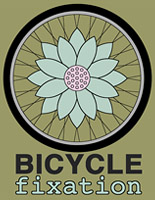Given the enormous amounts of political and emotional effort, as well as
increasingly scarce public cash, given over to justifying and building bikepaths
in the name of urban ecology, I think it is worth asking whether that effort and that
money are, in fact, actually useful or beneficial.
People often presume that you have to build bikepaths
before you can use bicycles effectively for urban transit.
However, there already exists an intricate and comprehensive system of bikeways that extends throughout the length and breadth of every urban agglomeration on earth, and it is called "city streets."
Rather than pour money into glorified sidewalks that, as someone once said of yachting, "go slowly nowhere at great expense," or into putting up signs that are ignored by motorists and bicyclists alike, spend it wisely on educational programs that will teach bicyclists (who are people on bicycles) how to ride safely and politely in traffic, and that will remind motorists (who are people in cars) of their obligations in regard to the rights of cyclists.
Three major statistical studies have shown that bicyclists on separate bikepaths have an accident rate over two and a half times higher than that of bicyclists on the street. (These studies were commissioned by the AAA, by the CHP, and by a bicycle advocacy group; all three came to the same conclusions. See John Forester's Effective Cycling at your local bookstore or library.)
The experiences of thousands upon thousands of real-world riders show that >riding in traffic, as traffic, is the safest way to use a bicycle for transportation. People who use separate bikepaths are impeded from learning the skills they need to use their bikes on the streets, which is the only way to use bikes effectively to get to places you need to get to in a reasonable time. The same studies also show that the majority of accidents that did occur--most of them involving cars failing to yield right-of-way to bikes, or bikes turning inadvertently in front of cars--are of types that could be addressed by educating the parties involved.
There is also an interesting financial perspective. Accounting studies have shown that the taxes currently imposed on motor vehicles in this country do not cover the actual costs of maintaining an infrastructure of roads, signals, police services, etc. etc. that motor vehicle use requires, let alone the social costs relating to pollution (and its abatement), congestion (and its accommodation), the obliteration of open land for parking, storage, and maintenance facilities, the destruction of neighborhoods for freeways, the isolation imposed on individuals by car usage and on neighborhoods by road configurations, individual health degraded by car-required sedentarism, and so forth and so on, and on, and on. (Mark E. Hanson, "Automobile Subsidies and Land Use," Journal of the American Planning Association, vol. 58, No. 1,1992, pp. 60-71, among others.)
Therefore, bicycles, which use an infinitesimal share of the infrastructure, are charged disproportionately in their use of the same. To put it bluntly: in a literal financial sense, I own more of the road when I am riding on it on my bicycle than when I am driving on it in a car.
The historical perspective also supports the rightful place of bicycles on the common roads: the roads and highways system in this country was originated in response to the "Good Roads" movement of the post-Civil War decades. This movement was a program of bicycling groups of the time, who were tired of riding on bumpy wagon paths. Bicycles were considered largely as transportation then, and the roads were originally improved to facilitate bicycle use. Car culture unfortunately owes the ease of its development in part to bicycle culture.
In a realistic global sense, cars simply do not have primacy over bicycles. Bicycles move more people and more goods than any other form of land transportation now in use worldwide, and more bicycles are in use worldwide than any other vehicle (presently about 900,000,000). Bicycles are essential to the economies of China, India, Southeast Asia, and Africa, and to the cultures of Northern Europe. In Holland, one of the most civilized of countries (as well as one of the coldest and wettest), bicycles are used for 29% of all personal transportation, and they are heavily used in Germany, Scandinavia, France, and Italy, as well as in North American cities such as New york, Philadelphia, Chicago, San Francisco, Toronto, Seattle, and Portland--places with some of the worst weather on the continent.
In other words, the roads are the safest place to be once you learn how to use them, and "they" owe us our place in the lane anyway. Let's direct our efforts to making the roads more available to bicyclists, and bicyclists--ourselves--more able at using the roads. Learn how to ride safely, learn how to carry groceries, learn how to forgive the ill-mannered drivers who have not yet learned that to be slow and exposed can also mean to be free and alive. Almost everyone out there in those tin boxes is a potential bicyclist. It's up to you to show them that it's not only beautiful, but feasible. The emphasis on bikepaths tells people that they can ride only on bikepaths.
See also Ian Fiddies' The Safety Paradox and The Dangers of Cycle paths, And Eric Britton's Lessons Learned in Europe.

